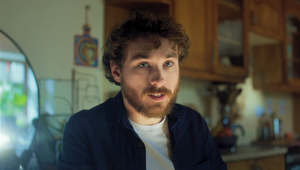
One Shot, 190 Years, and the Heart of Irish Rail

190 years of history in 30 seconds. That was the challenge that creative director, Peter Dobbyn, and director, Dermot Malone, were tasked with. The project was a collaboration between Publicis Dublin and production company, Banjoman, for Iarnród Éireann (Irish Rail).
Peter tells me that the original mandate was straightforward: show the pride and progress of the railway. “The railway has endured for so long. Through war, famine, and many challenges,” he explains. “It’s not just about the tracks and trains – it’s about the people who built, maintained, and relied on them.” That would set the tone for the entire campaign. The idea was to keep things simple and honest, something that felt naturally aligned with the long history of Ireland’s railway.
When I ask Peter and Dermot about when they first met, they chuckle with the vivacity of schoolboys. “We go way back,” says Peter. The pair have known one another for years, and worked together on numerous projects. They bounce off one another in symbiosis – it’s this foundation of trust, and mutual respect behind the camera, that pays dividends in the final film.
When the time came to select a director, Peter was certain that Dermot was the best fit. “We knew he was the right person for the job. Emotive storytelling is his bread and butter, but also the trust element is there,” Peter tells me.
When Dermot came on board, he knew the challenge would be the timeframe, adding, “We decided early on that the film would begin and end on the track.” The film features, distinctively, a single continuous shot. Therefore, every element, from the movement to the lighting, hanging out of a moving vehicle, had to be meticulously planned to ensure the natural unfolding of the story. “That left us with very little margin for error.”
The spot opens in black and white, a nod to the past. As the shot progresses, the film gradually transitions into colour, showing the passage of time – a visual cue telling the story of evolution and progress. After a long day of filming, they decided in the end to do one final shot. “And we’re glad we did,” says Dermot. “That’s when we got a burst of golden hour light that just split through. It was one of those moments where you look at one another, and everyone just knows that’s it.” For the team, the light felt like a confirmation that they’d captured what they had set out to: something real.

Pictured above: Dermot Malone (Left) and Peter Dobbyn (Right)
Another pivotal decision would come down to the narration. As the shot progresses on the lines, flying through decades, the rail itself tells its story. Peter and Dermot explain that evoking emotion in the viewer is never an easy feat, but having people at the centre usually helps. It’s much more challenging when you’re telling the story of something seemingly inanimate, like the rail. The personification of the rail heightens viewer sentimentality, but deciding on the best kind of voice had the team scratching their heads for a while.
Peter explains, “We really sweated the voice selection. We wanted something that embodied the feeling of the tracks: old, gravely, timeless. When we heard Barry McGovern utter those first six words, 'I’ve been here a long time,' we knew we were on to something special.”
It was also important to bring back the human element on the sidelines as the journey unfolds. Along the track, names and dates appear – from Liam Ó Broin in 1856 to Sofia Byrne today – the small markers act as reminders of the very real people with very real lives who maintain the railway.
“Showing those names and dates grounds the story in reality,” says Dermot. “It’s a way of saying that behind every rail, there’s a person who’s dedicated their life to keep things moving.”
When I ask Peter and Dermot about the things that went wrong throughout, they’re quick to tell me that while not without its regular challenges, the film was a joy to work on. “It was one of those rare occasions where everything just seemed to go our way,” says Peter, as Dermot agrees. There’s so much to be said for just how far good relationships can take you – and when working towards a goal that everyone on and off camera believes in, the results can be pretty special.
But what made the project worthwhile for the team was seeing the genuine reactions of those who have worked for Iarnród Éireann – having been trusted with telling a story that really matters to so many people. The outcome is a record of a part of Ireland’s history that feels honest, measured, and unforced, drawing attention to the legacy of those who have kept the nation moving forward.
The film’s narrator says it best, “This isn’t the end of the line for me; it’s only the beginning.”















